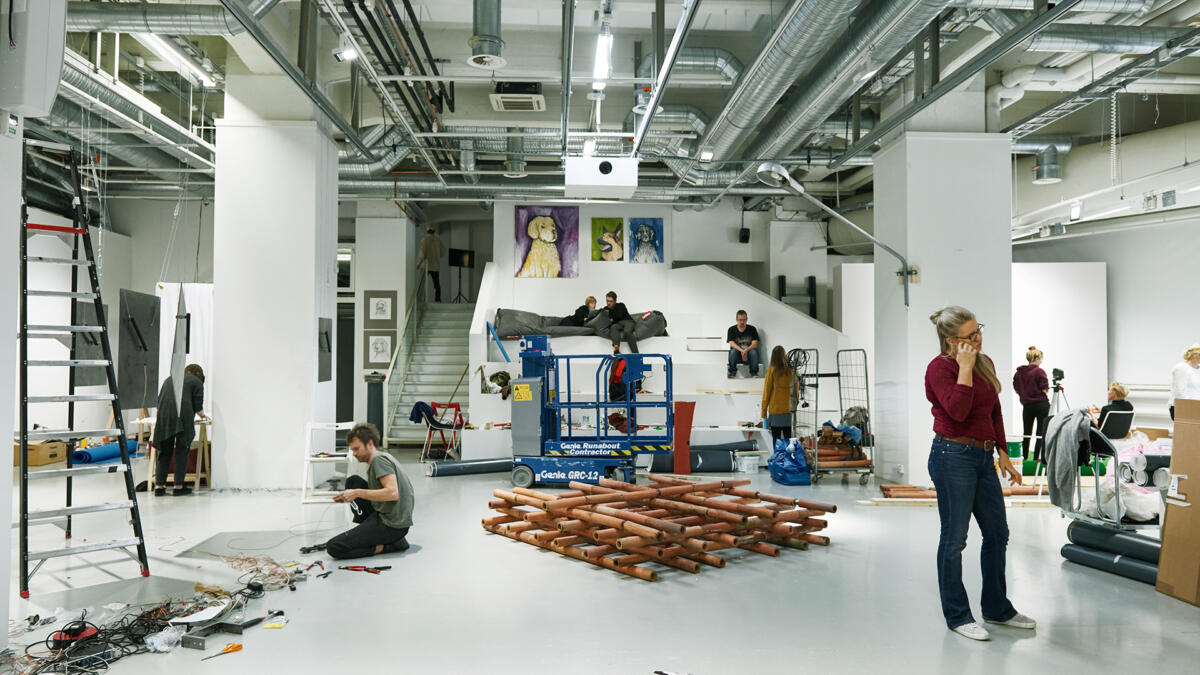The Praxis master’s programme provides the skills to work as an expert in contemporary art
Upon graduation, students of the renewed master’s programme can work, for example, as curators, researchers, writers or other professionals in the field of contemporary art.

Praxis has now been expanded to be more versatile than before, and its new name is Praxis – master’s programme in curating and writing in contemporary art. Eight students are accepted each year, while previously five or six students were accepted every other year.
“We wanted to open the master’s programme to a larger group of students and guide students to specialise in diverse mediation roles and research. There is a clear need to strengthen the structures and expertise of mediator roles in the field of contemporary art in Finland. Alongside the individual study path, we encourage students to engage in various types of collaborations,” says Academy of Fine Arts lecturer Taru Elfving. She has been the teacher in charge of the Praxis master’s programme in 2023-2024.
Looking for people with various backgrounds from both Finland and abroad
Praxis is looking for people who are passionate about contemporary art and are interested in developing the field. The programme welcomes applications from students who have previously studied, for instance, art history, visual arts or something completely different. Their previous education can also be from a university of applied sciences, for example. An individual study plan is created for each student.
“The field of contemporary art requires diverse skills and specialisations. Praxis is suitable for both students with a more theoretical background and those who have already worked in the field. Students apply with a portfolio and a motivation letter, in which they can share their experience and interests in their own words. The portfolio can include, for example, the applicant’s own artistic or curatorial work, descriptions of projects completed during previous studies and work or internship assignments,” Elfving says.
Both Finnish and international students are welcome and applications from candidates of all backgrounds, including those from underrepresented groups, are more than encouraged.
“During the studies, a professional network is created, and language skills are important in an international working environment,” Elfving continues.
The programme collaborates with various universities, international thinkers and teachers. Similar study tracks can be found in Europe and beyond, and international exchange is strongly encouraged.
Many graduates of Praxis work as curators, but the master’s programme also equips them for many other expert roles.
“Praxis also encourages students to create new models and methods that can develop the structures of the art world. Structures are not permanent, and the role of art in society is constantly changing,” says Elfving.
Unique opportunity to study alongside visual artists
A unique feature of the Praxis Master’s programme is the combination of theory and practice.
Students at Praxis participate in collaborative projects with students studying to become artists.
“Our students study alongside and in collaboration with fine arts students. They gain an excellent understanding of the work of artists in the dynamic field of contemporary art. They learn about the diverse potential roles of curators and get to network with museums and galleries during their studies,” says Elfving.
Praxis also places more emphasis on writing about art.
“There are many forms of art writing. For example, we teach art criticism, writing for different audiences and research articles. Students practice writing for traditional media and digital platforms. The amount of published art criticism has decreased significantly, so we are considering various possible new forms of art writing and criticism. Writing has a significant role also in curating as exhibition activities are contextualised in relation to the art field and as part of societal debates,” says Elfving.
Bridging contemporary art history and theory with curating and writing
Professor of contemporary art studies Riikka Haapalainen, who has also been part of the development of the renewed Praxis programme, leads the bachelor’s programme in contemporary art history and theory at the Academy of Fine Arts. Her focus has been to bridge the bachelor’s programme to the Praxis programme.
“We do not offer just curatorial training, but very broad training for actors in the art field. We combine art theory, art history and practice. Praxis offers students the opportunity to continue from the bachelor’s to master’s studies at Uniarts Helsinki. It deepens and expands what you learn in the bachelor’s programme,” Haapalainen says.
The programme language for the bachelor’s programme will continue to be Finnish, although teaching will also be done in English. The studies at Praxis are entirely in English.
Road to postgraduate studies
Praxis also allows students to continue to doctoral research, for example at Uniarts Helsinki.
“In Praxis we also now want to emphasise critical art writing. Students learn specialist language and a common-sense way of writing and talking about art. This also enables postgraduate studies,” says Haapalainen.
Artistic research is typically done by artists. Although a Praxis student does not have to be an artist, they can study practices in the field of art.
“Recently, curatorial research that combines theory and practice has increased alongside artistic research. In all universities, interdisciplinary research is gaining ground, and the same phenomenon is visible in artistic and curatorial research,” says Elfving.
Text: Päivi Brink